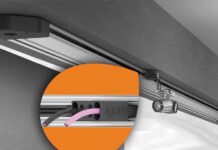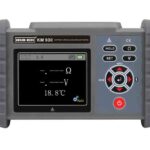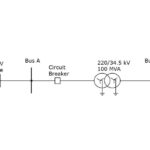
Partial Discharges (PDs) are one of the main causes of insulation deterioration in medium and high-voltage power cables and are a very reliable indicators of the presence of developing insulation faults. PD can spread and weaken power cable insulation to the point where failure occurs. Offline PD testing is a highly reliable method for assessing the quality of the insulation of medium and high-voltage cable systems during manufacturing, onsite commissioning, maintenance, testing, and troubleshooting.
When is PD measured on power cables?
Offline PD tests on medium- and high-voltage cables initially take place in the cable factory, where they help reveal manufacturing-related insulation faults. In accordance with international standards, a test voltage higher than the cable’s normal working voltage is applied during factory acceptance tests. This offline test is intended to determine whether the cable insulation is free of PD before the power cables are installed and put into operation.

Even if the cable passes the PD test at the factory, damage to the joints and terminations can occur during cable installation. Therefore, the PD test is also important during the onsite acceptance test to assess the condition of the insulation of the installed cable system before it is put into service. In addition, regular onsite PD tests can be used to assess the dielectric condition of the cable systems as they age, such as during in-service testing or troubleshooting when a problem is suspected.
Online PD measurements are often used for in-service testing on power cables. The PD sensors, namely High-Frequency Current Transformers (HFCTs), can be permanently installed to enable measurements to be performed without taking the cable system offline for the test. In this case, PD measurements focus on the field-installed accessories, such as the cable terminations, for detecting and locating partial discharges in cables. It is often recommended during after-installation testing to combine AC voltage testing with sensitive on-site PD measurements to detect defects in aging insulation before a failure occurs. The following case study illustrates the importance of taking the results of such PD tests seriously.
Highly beneficial for condition assessments
One of the greatest benefits of measuring PD in cables is the ability to make quality assessments in the factory and maintenance decisions in the field based on the actual condition of the cable. The presence of PD activity is a reliable indication of manufacturing defects and damage during installation, as well as the first indication of deterioration in the insulation system of aging cables. This enables problems to be addressed either before the cable is installed or before it reaches the point of total failure and avoids unexpected and costly system outages, thus improving cable reliability. Regular PD measurements enable comparisons of measurement data and, thus, an assessment of how the insulation condition develops over time.

Next generation PD measurement system
The MPD 800 universal PD measurement and analysis system is the next generation of innovative MPD technology for PD testing from OMICRON. The system’s very high measurement accuracy and advanced analysis capabilities enable users to reliably assess the severity of partial discharge activity in the insulation of power cables and detect and locate defects that could potentially lead to failure.

performing specific types of PD tests…
Universal PD testing solution
The MPD 800 performs PD measurement and analysis according to IEC and IEEE standards on power cables and other electrical equipment, such as motors generators and power transformers, during routine and type testing, factory acceptance testing, onsite commissioning, as well as troubleshooting in the field. For the different types of PD tests on power cables, user profiles and measurement configurations with specific test parameters can be set up that save time during testing.


Synchronous multi-channel PD measurements
The MPD 800 has two PD input channels, enabling synchronous multi-channel measurements or real-time gating of the measurement to suppress interference, namely external noise. Several MPD 800 devices can be linked together with fiber optic cable for multiple measurement points to enable a more comprehensive assessment of the insulation system and reliable location of faults along the entire cable length. A powerful 3PARD filter helps in reliably differentiating between harmful PD and external interference to quickly determine the PD signal source.
High sensitivity for locating insulation faults in power cables
State-of-the-art broadband PD localisation filters, multi-channel time domain reflectometry (TDR), a large localisation range (> 130 µs), and statistical (sTDR) localization methods allow insulation faults to be located quickly along the entire cable length.
Conclusion
Partial Discharges (PDs) are a very reliable indicator of the presence of insulation faults and one of the main causes of insulation degradation in power cables. The universal MPD 800 PD measurement and analysis system offers advanced features to make PD tests on power cables fast and efficient, whether at the factory or in the field. The system enables the precise detection, analysis and localization of insulation defects in power cables to allow a reliable assessment of insulation condition to avoid failure.
Case Study: In-Service PD Testing on a 220 kV XLPE Cable
In-service PD measurements were performed on a 220 kV XLPE cable with a length of 100 m in an outdoor air-insulated substation using OMICRON’s MPD 800 PD measurement and analysis system. The measurements were performed using OMICRON MCT 100 HFCTs which were pre-installed on the grounding shield of the cable at the gas insulated substation (GIS) and at the overhead line (OHL) cable terminations.
Ensuring a sensitive PD measurement
Synchronous multi-channel measurements with source separation techniques, such as 3PARD (3-phase amplitude relation diagram), were used to allow a sensitive PD measurement in the noisy environment, which is common in outdoor air-insulated substations. By examining individual clusters in the 3PARD diagram, a separation between noise and PD phenomena was possible. As a result, noise coming mostly from the substation’s overhead lines was successfully separated. The internal PD signal was detected at the middle phase of the cable line (phase S).
Testing at various frequencies
To gain more information about the PD source type and its location, the PD measurements were performed at various center frequencies: 5 MHz, 7 MHz, 9 MHz, and 11 MHz.
It was noticed that the amplitude of the signal and the repetition rate of the PD pulses (about 130 pulses/sec) remained independent of the selected measuring frequency. Also, the shape of the patterns remained similar. As the attenuation of the PD signal was very low between 5 and 11 MHz, it could be assumed that PD activity was taking place very close to one of the measurement sensors, namely in the GIS cable termination of phase S.
The PD signal detected during the measurement had intermittent behaviour, so it was decided to use OMICRON’s MONTESTO 200 online temporary PD monitoring system to continuously track this behaviour over a short period of time.
It was decided to stop the temporary monitoring after 18 hours, even when continuous monitoring was recommended. After five weeks of operation, a failure actually occurred where PD activity was originally detected with the MPD 800 system at the middle phase of the cable (phase S). The trace of the failure was found 40 cm far from the edge of the termination stress cone, near the connecting clamp to the GIS bus bar.

Ole Kessler studied electrical engineering at the Technical University of Berlin. In 2009 he joined OMICRON Energy Solutions in Berlin as an application engineer and specialised in the measurement of partial discharges. He has also worked as a trainer and conducted seminars on PD measurement for customers around the world. He currently works as a product manager for the company’s MPD family of PD measurement and analysis systems.



















